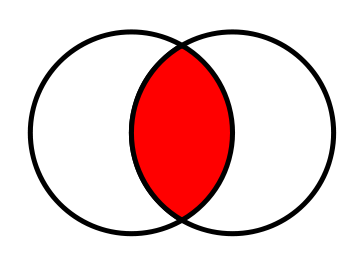INTERSECT – the Underestimated Two-Way IN Predicate
Have you ever wondered how you could express a predicate that “feels” like the following, in SQL:
WHERE Var1 OR Var2 IN (1, 2, 3)
/u/CyBerg90 has, on reddit. The idea was to create a predicate that yields true whenever both values Var1 and Var2 yield either 1, 2, or 3.
The canonical solution
The canonical solution would obviously be to write it all out as:
WHERE Var1 = 1 OR Var1 = 2 OR Var1 = 3 OR Var2 = 1 OR Var2 = 2 OR Var2 = 3
A lot of duplication, though.
Using IN predicates
Most readers would just connect the two IN predicates:
WHERE Var1 IN (1, 2, 3) OR Var2 IN (1, 2, 3)
Or the clever ones might reverse the predicates as such, to form the equivalent:
WHERE 1 IN (Var1, Var2) OR 2 IN (Var1, Var2) OR 3 IN (Var1, Var2)
Nicer solution using EXISTS and JOIN
All of the previous solutions require syntax / expression repetition to some extent. While this may not have any significant impact performance-wise, it can definitely explode in terms of expression length. Better solutions (from that perspective) make use of the EXISTS predicate, constructing ad-hoc sets that are non-empty when both Var1 and Var2 yield either 1, 2, or 3.
Here’s EXISTS with JOIN
WHERE EXISTS (
SELECT 1
FROM (VALUES (Var1), (Var2)) t1(v)
JOIN (VALUES (1), (2), (3)) t2(v)
ON t1.v = t2.v
)This solution constructs two tables with a single value each, joining them on that value:
+------+ +------+
| t1.v | | t2.v |
+------+ +------+
| Var1 | | 1 |
| Var2 | | 2 |
+------+ | 3 |
+------+Looking at a Venn Diagram, it is easy to see how JOIN will produce only those values from t1 and t2 that are present in both sets:
Nicest solution using EXISTS and INTERSECT
However, people might not think of a set intersection when they read JOIN. So why not make use of actual set intersection via INTERSECT? The following is the nicest solution in my opinion:
WHERE EXISTS (
SELECT v
FROM (VALUES (Var1), (Var2)) t1(v)
INTERSECT
SELECT v
FROM (VALUES (1), (2), (3)) t2(v)
)Observe, how the length of the SQL statement increases with O(m + n) (or simply O(N), where m, n = number of values in each set, whereas the original solutions using IN increase with O(m * n) (or simply O(N2)).
INTERSECT Support in popular RDBMS
INTERSECT is widely supported, both in the SQL standard as well as in any of the following RDBMS that are supported by jOOQ:
- CUBRID
- DB2
- Derby
- H2
- HANA
- HSQLDB
- Informix
- Ingres
- Oracle
- PostgreSQL
- SQLite
- SQL Server
- Sybase ASE
- Sybase SQL Anywhere
In fact, the following databases also support the less commonly used INTERSECT ALL, which doesn’t remove duplicate values from resulting bags (see also UNION vs. UNION ALL)
- CUBRID
- PostgreSQL
Happy intersecting!
| Reference: | INTERSECT – the Underestimated Two-Way IN Predicate from our JCG partner Lukas Eder at the JAVA, SQL, AND JOOQ blog. |






Ummm…. Won’t both the JOIN and the INTERSECT versions be satisfied if only one of the vars is 1, 2 or 3 instead of both?
You’re right, of course. This was a mistake in the original article:
http://blog.jooq.org/2015/08/04/intersect-the-underestimated-two-way-in-predicate
The mistake is the fact that AND is used in the first three queries to connect the IN predicates, when OR should be used…